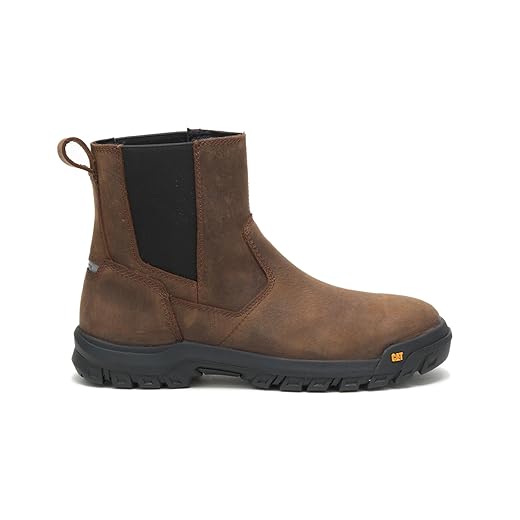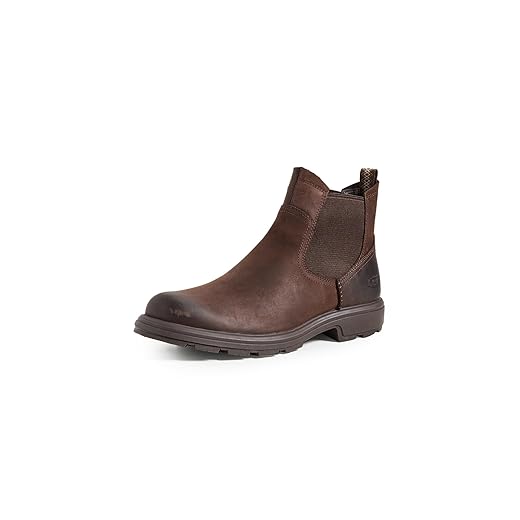A pull-on work boot is a type of work boot that lacks laces and is designed to be easily slipped on and off without the need for traditional lacing. Instead of a lace-up closure, pull-on work boots typically have elastic side panels, pull tabs, or other mechanisms that allow the wearer to “pull on” the boots with minimal effort.



Key features of pull-on work boots include:
- No Laces: The absence of laces distinguishes pull-on work boots from lace-up styles. This design choice offers convenience, especially in work environments where speed and ease of putting on and taking off boots are essential.
- Elastic Side Panels: Many pull-on work boots feature elastic side panels on both sides of the shaft. These panels allow the boots to stretch, making it easier to slip the foot into the boot while providing a snug fit once worn.
- Pull Tabs or Loops: Pull-on work boots often have pull tabs or loops located at the top of the boot shaft. These serve as handles for pulling the boots onto the feet.
- Chelsea Boot Style: Some pull-on work boots are designed in a Chelsea boot style, which is characterized by its ankle-high height, elastic side panels, and absence of laces. Chelsea-style pull-on work boots are popular for their streamlined and versatile appearance.
- Safety Features: Despite the lack of laces, pull-on work boots are available with various safety features, such as steel toes, composite toes, or alloy toes for protection against impacts and compression. Some models may also offer puncture-resistant soles, electrical hazard protection, and slip resistance.
- Variety of Materials: Pull-on work boots are made from a variety of materials, including leather, synthetic materials, or a combination of both. The choice of material depends on factors such as durability, water resistance, and breathability.
Pull-on work boots are commonly chosen by individuals working in industries such as agriculture, construction, and manufacturing, where the convenience of quickly putting on and taking off boots can be advantageous. Additionally, those who value a lace-free, slip-on design may find pull-on work boots to be a practical and comfortable choice for their work environment.
How should pull on work boots feel?
Pull-on work boots should feel comfortable and supportive to ensure optimal performance and safety in the workplace. Here are some guidelines on how pull-on work boots should feel:
- Secure Fit:
- The boots should fit snugly around the foot without being too tight or too loose. A secure fit helps prevent the foot from sliding inside the boot, reducing the risk of blisters or discomfort.
- Toe Space:
- There should be enough room for your toes to wiggle comfortably. The toe box should provide ample space without feeling cramped, allowing for natural movement.
- Heel Fit:
- The heel should fit securely without excessive movement. A snug fit in the heel area is essential for stability and preventing blisters.
- Arch Support:
- Pull-on work boots should provide adequate arch support. The arch of your foot should align with the arch support of the boot, offering comfort and reducing fatigue during long periods of wear.
- No Pinching or Pressure Points:
- The boots should not pinch or create pressure points on your feet. Check for any areas where the boot may rub against your foot, as this could lead to discomfort and blisters over time.
- Heel Height:
- Ensure that the heel height feels comfortable and provides the necessary support. The heel should not be too high or too low, promoting a natural and stable walking gait.
- Ease of Entry:
- Since pull-on work boots lack laces, it’s important that they are easy to pull on and off. The elastic side panels or other mechanisms should allow for a smooth entry without excessive effort.
- Stability and Traction:
- Walk around in the boots to assess stability and traction. The boots should provide a solid grip on the ground, reducing the risk of slips or falls.
- Consider Socks:
- When trying on pull-on work boots, wear the type of socks you would typically wear during work. This ensures a more accurate assessment of the fit, especially if you wear thicker socks for added comfort or warmth.
- Break-In Period:
- Keep in mind that some boots may have a break-in period. While they should feel comfortable initially, they may become even more comfortable after wearing them for a short period.
If you’re purchasing pull-on work boots online, be sure to check the sizing chart provided by the manufacturer and read customer reviews to get insights into how the boots fit. If possible, try on the boots in-store or order from retailers with a flexible return policy to ensure you can exchange them if the fit isn’t right. Your comfort and safety are paramount, so investing time in finding the right fit is essential.
How do you wear pull on work boots?
Wearing pull-on work boots involves a straightforward process, as they are designed to be easily slipped on and off without the need for laces. Here are the general steps on how to wear pull-on work boots:
- Ensure Proper Sizing:
- Make sure you have the correct size of pull-on work boots. The boots should fit comfortably and provide adequate support without being too tight or too loose.
- Prepare the Boots:
- Check the pull tabs or loops located at the top of the boot shaft. These are designed to assist in pulling the boots onto your feet.
- Open the Shaft:
- Hold the pull-on work boot with one hand on each side of the boot shaft. Use your thumbs to open up the shaft, creating a wider opening.
- Slide Your Foot In:
- With the shaft open, gently slide your foot into the boot. If the boots have elastic side panels, these will stretch to accommodate your foot.
- Use Pull Tabs or Loops:
- If your pull-on work boots have pull tabs or loops, use them to assist in pulling the boots onto your feet. Grasp the tabs or loops with your fingers and pull upward.
- Adjust the Heel:
- Ensure that your heel is properly positioned in the boot. Make any necessary adjustments to ensure a snug fit around the heel area.
- Position the Foot:
- Once your foot is in the boot, position it comfortably within the toe box. Make sure your toes have enough space to move without feeling cramped.
- Repeat for the Other Foot:
- Repeat the process for the other foot to put on the second boot.
- Check for Comfort:
- Stand up and walk around to check the comfort and fit of the pull-on work boots. Ensure that your feet are properly supported and that there are no pressure points or discomfort.
- Adjust as Needed:
- If necessary, make any final adjustments to ensure a comfortable and secure fit. Pay attention to the heel, arch, and overall feel of the boots.
- To Remove:
- To take off pull-on work boots, use the pull tabs or loops to assist in pulling them off. Hold onto the tabs or loops and gently pull the boots off your feet.
It’s important to note that the ease of putting on and taking off pull-on work boots can vary based on the specific design and features of the boots. Additionally, individual preferences may play a role in how comfortable and convenient pull-on boots are for different users.
Related Posts
SofaBaton X1S Universal Remote Review – Control Everything with One Smart Remote
Add Your Heading Text Here Products recommended in the post...
Read More☕ Ninja Luxe Café 3-in-1 Coffee Machine Review – Barista-Quality Brews at Home
🌞 Quick Introduce If you dream of café-quality drinks at...
Read More🌬️ BLUEAIR Air Purifier Review – Smart, Stylish, and Powerful for Large Homes
Quick Introduce Air quality matters more than ever—whether it’s dust,...
Read MoreTired of Pet Hair? This Shark Cordless Pet Vacuum Might Be Your New Favorite Tool
Say hello to your new favorite cleaning weapon: the Shark...
Read MoreProducts recommended in the post contain affiliate links. We may receive a commission when you buy something through our posts.
Why Trust Us
You will find what you are looking for at Black Friday Weeks. From classic to luxury brands, you'll find both. We will help you to select appliances that fit your needs, budget and lifestyle. Whether you want to stop by to learn more — or plan to make a major purchase — we’ll treat you like family and assist you every step of the way. Shop with us today to receive friendly and experienced help along the way.








